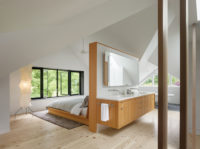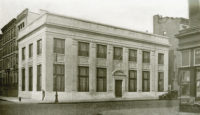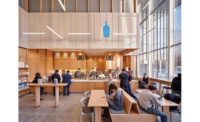To drive to Point Roberts, Washington, you have to cross the United States'Canada border twice, making a U-turn above the 49th parallel: its peninsula juts into the water south of Vancouver, separated from the rest of the United States by the Strait of Georgia.
On the southeastern tip of the exclave, Bohlin Cywinski Jackson (BCJ)'known for its tectonic residences whose clarity of form and materials often have ample budgets'has designed what could be thought of as a contemporary Case Study house, built for $210 per square foot. The client was the firm's longtime collaborator, architectural photographer Nic Lehoux, who shares the residence with his partner and their toddler daughter. The rectangular, charcoal-colored two-story wood house is sited in an existing clearing in a dense old-growth forest. A combination of a balloon frame structure and platform structure made of off-the-shelf dimensional lumber, it is defined by two volumes that appear 'zipped' together. Internally, they are divided by a hallway running east'west. BCJ principal Robert Miller also designed a ramp that will extend this datum line outside and guide visitors from the road to the house. The walkway and a deck are under construction.
'It's been a lifelong interest to generate modernism on a budget,' says Miller, whose childhood bookshelves were filled with his father's issues of Mechanix Illustrated and Popular Mechanics. 'I think I memorized every page. When an opportunity like Nic's comes along, it takes me back to those deep-seated interests.' For Lehoux's house, Miller concentrated on eliminating anything unnecessary, assembling without cutting and fabricating, and creating a 'special moment in space that rivals a child's treehouse or a fort,' he says.
The southern volume is a glass box, interspersed with economical fiber-cement panels for energy savings and to maintain privacy. In it, Miller stacked bedrooms and private spaces on top of the kitchen and living room. Dappled, ever-changing light streams through 5-foot-wide glass panes set in an aluminum system. The living room, to the east, seems to be floating in the forest. Above it, a glass balustrade protects a second-floor mezzanine. The feeling of being enveloped in the forest is heightened by the fact that the windows extend a couple of inches above the slightly dropped hemlock ceiling. This space was originally going to contain the master bedroom until Lehoux realized that the view'and the feeling of being in a treehouse'was too magical to waste on a room used for sleeping (the master bedroom is instead at the western end of the house).
In contrast, the house's northern volume is mostly solid, clad in shiplap cedar and painted with svarttj'ra, a traditional durable Swedish coating made from pine tar. Narrow glazed incisions amplify the horizontal form, which contains a stair connecting the two floors. Wood slats make up a wall that encloses the stairwell, topped with an operable skylight, and similar slats are used to screen off the living room from the hallway, in a nod to Japanese design. 'It gives a sense of openness and privacy at the same time,' says Miller.
Called the Lightbox, in part because of Lehoux's profession and also because it glows at night, the house contains many references'to Charles and Ray Eames's house in Pacific Palisades, California; the DIY hippie houses of Christiania, in Copenhagen (particularly one made of recycled windows); and the farm buildings and pole barns of Miller's native northwestern Pennsylvania. 'Seven or eight years ago, [Miller] gave me this magazine called Rural Builder,' says Lehoux, who grew up in rural Quebec. 'I thought, 'There's a man after my own heart.' ' Adds Miller: 'You have to have an appreciation for it. No one's more creative than farmers. They always have to be innovating.'
Lehoux, who might be in New York one week and Afghanistan the next, splits the rest of his time between Vancouver and Point Roberts. He discovered Point Roberts when an assistant urged him to visit; he came on a rare stormy day in June of 2004. 'I was smitten,' he says. He looked at several properties for sale before he came upon the 80-by-140-foot lot he now owns. He paid $17,000'a steal compared to Vancouver prices'in cash the day after seeing it (he later bought an adjacent lot plus one across the street, where he plans to build a studio, also designed by BCJ). After developers failed to build a golf course behind the property, 400 acres were turned into a land trust. Lehoux calls this his 'backyard''its forested paths, leading to the beach, have views of the Strait of Georgia and the San Juan Islands.
Not long after Lehoux purchased the property, Peter Bohlin, a founding principal of BCJ, came to see it and told Lehoux that he wanted to design a house for him. 'I said, 'Peter, I would like nothing more, but I can't afford one of your houses,' ' recalled Lehoux. ' 'I will live vicariously by shooting them for the foreseeable future.' I think that was an interesting challenge for them.' Lehoux ended up trading photography for design services, with a result'in scale, proportion, and siting'that is quite similar to Bohlin's original sketch. 'It's also thanks to a lot of ideas that Robert brought,' says Lehoux.
The pared-down flexible system used for the Lightbox is one that Miller believes could be applied to 5,000 square feet just as well as 200. 'It is a careful balance of elegant proportions and scale. The luxury, if you call it that, is not in layers of marble but in being immersed in the forest,' says Miller.
Size: 1,650 square feet
Construction Cost: $346,500
Completion Date: 2015
Architect:
Bohlin Cywinski Jackson
1932 First Ave Suite 916
Seattle, WA 98101
PeopleClient: Nic Lehoux Architect Personnel in architect's firm who should receive special credit: Engineers: General contractor: HBHansen Construction Photographer(s): |
ProductsStructural system Exterior cladding Wood: 1x6 Cedar shiplap siding Roofing Windows Glazing Skylights: Velux Skylight Doors Sliding doors: Sliding doors by Fleetwood Interior finishes Paints and stains: Black pine tar stain, Svartjara by Auson Special surfacing: Zinc kitchen countertops and Quartz vanity countertops Special interior finishes unique to this project: Exposed concrete floors on ground floor and Douglas Fir car decking throughout second floor, Exposed wood framing throughout with linseed oil finish Lighting Plumbing Energy |
























Post a comment to this article
Report Abusive Comment